Firstly, more Botani life (Krita)
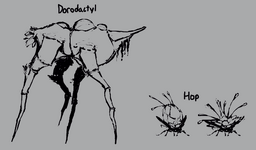
Dorodactyls, or Spearlegs, are grazing Botani which grow upwards of 40 feet tall. mostly found in warm, moist climates where the soil is marshy. They spend most of their time between chasing starlight and absorbing the water from the soil beneath them. Their long, pointed limbs sink deep into the ground, where they can absorb copious amounts of untapped groundwater. dipping from their frontside are many sensory organs which detect the chemicals in the air The large bubbles along their backs are filled with such water as well as tiny seeds. A Dorodactyl reproduces with its pollenated seeds as it grazes in much the same way, through the limbs, deep into the ground. A Dorodactyl can take upwards of 70 Earth Years to fully mature, though they only begin reproducing about whenever they begin to reach their full size.
Hops are very small single-flowered Botani, making them vaguely related to Orchidae. They can grow up to 6 inches in height, and prefer moderate climates. They have 8 legs, and 2 folded limbs which are about 7 inches when fully extended, which help it while prone or while scaling difficult surfaces. A Hop can live up to 20 Earth Years, and only flowers when sufficient Starlight is shining per day. They secret a very bitter oil when threatened.
Secondly, the development of Orchidae as a design
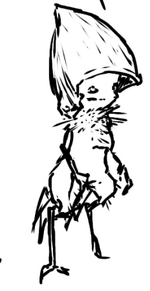
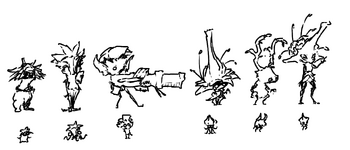
Since I have never really displayed the effort into some species' conception and development, I thought I'd do so here! The initial premise of plant-people proved to be an interesting, expansive, and imaginative endeavor, allowing for lots of different possibilities and points of reference. Shown on the right was the very first design, alongside which were the initial designs for Germaniites and standing design for the Chondrich. Based on wild oat seeds, the design was quickly scrapped in favor of more favorable flowering alternatives. Shown to the right are prototypes for the Perianthites, with the most right is the design that would eventually become the Orchidae you can begin to recognize now! Alongside this are the eventual designs for the goliath Beluanae and the smaller Pistilinae.
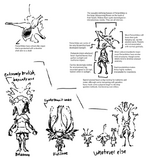
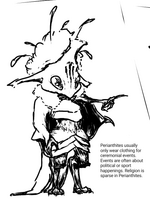
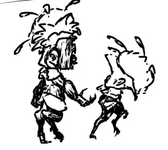
This is where their first design was established, where I first established their general physiological and societal attributes.
Perianthites are long-living single-flower Botani that bear 3 petals from their head, and a mass of threads which bear pollen when reproducing. Their flowers are always blossoming, and their seeds emerge from below their face with a sort of secretion. Their faces are a stark contrast to the rest of their body, with an often off-white coloring with a unique pattern across it. Much of their body is covered in a tough carapace resembling Earthen insects, and their shoulders and most of their body is covered in layered leaves, which is how they absorb starlight. They have two sets of knees, and can burst into quick movement rather effectively. Perhaps they once had predators worth running from, but it appears they no longer exist.
Perianthite culture is established around sports. Most of their civilizations revolve around elaborate stadiums and colosseums, where tournaments and festivals take place. Religion is scarce between them, with most accepting life and death to their most natural forms. The most respected between Perianthites are the eldest, who happen to tend to be the strongest, playing into the sportsmanship between them. When it comes to strength and size, the Beluanae, a smaller, still major population among Perianthites dominates, towering above the common Orchidae. Perianthites, with their laid-back tendencies due to their anatomy, also engage mostly in the arts, theater, and games.
Although it may look similar to their current design, many aspects have been revised, and the Orchidae are intended to have a far more natural and expressive design than original depictions.
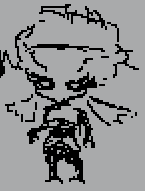
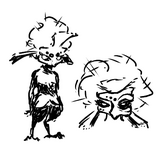
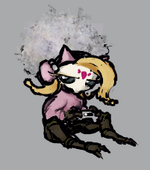
The first thing you may notice with the newer depictions is the much more expressive eyes, akin to the Hymenops. This was a suggestion from 1-3, and I think it really ties the design together! The black eyes with contrasting bright pupils and long lashes have become my personal favorite aspect of the Orchidae. Additionally, the stamen that used to stick from its head have been phased out, the leaves have become much more subtle, and the joints have continued to change over time, less like sticks and more like strong branches that can hold their weight.
With many renditions and development, I'd like to say that the Orchidae have gone from a simple plant-gimmick monster to a fleshed out, unique design that can really be resonated with, and are the most involved species I have contributed to Interspace.

Dorodactyls, or Spearlegs, are grazing Botani which grow upwards of 40 feet tall. mostly found in warm, moist climates where the soil is marshy. They spend most of their time between chasing starlight and absorbing the water from the soil beneath them. Their long, pointed limbs sink deep into the ground, where they can absorb copious amounts of untapped groundwater. dipping from their frontside are many sensory organs which detect the chemicals in the air The large bubbles along their backs are filled with such water as well as tiny seeds. A Dorodactyl reproduces with its pollenated seeds as it grazes in much the same way, through the limbs, deep into the ground. A Dorodactyl can take upwards of 70 Earth Years to fully mature, though they only begin reproducing about whenever they begin to reach their full size.
Hops are very small single-flowered Botani, making them vaguely related to Orchidae. They can grow up to 6 inches in height, and prefer moderate climates. They have 8 legs, and 2 folded limbs which are about 7 inches when fully extended, which help it while prone or while scaling difficult surfaces. A Hop can live up to 20 Earth Years, and only flowers when sufficient Starlight is shining per day. They secret a very bitter oil when threatened.
Secondly, the development of Orchidae as a design


Since I have never really displayed the effort into some species' conception and development, I thought I'd do so here! The initial premise of plant-people proved to be an interesting, expansive, and imaginative endeavor, allowing for lots of different possibilities and points of reference. Shown on the right was the very first design, alongside which were the initial designs for Germaniites and standing design for the Chondrich. Based on wild oat seeds, the design was quickly scrapped in favor of more favorable flowering alternatives. Shown to the right are prototypes for the Perianthites, with the most right is the design that would eventually become the Orchidae you can begin to recognize now! Alongside this are the eventual designs for the goliath Beluanae and the smaller Pistilinae.



This is where their first design was established, where I first established their general physiological and societal attributes.
Perianthites are long-living single-flower Botani that bear 3 petals from their head, and a mass of threads which bear pollen when reproducing. Their flowers are always blossoming, and their seeds emerge from below their face with a sort of secretion. Their faces are a stark contrast to the rest of their body, with an often off-white coloring with a unique pattern across it. Much of their body is covered in a tough carapace resembling Earthen insects, and their shoulders and most of their body is covered in layered leaves, which is how they absorb starlight. They have two sets of knees, and can burst into quick movement rather effectively. Perhaps they once had predators worth running from, but it appears they no longer exist.
Perianthite culture is established around sports. Most of their civilizations revolve around elaborate stadiums and colosseums, where tournaments and festivals take place. Religion is scarce between them, with most accepting life and death to their most natural forms. The most respected between Perianthites are the eldest, who happen to tend to be the strongest, playing into the sportsmanship between them. When it comes to strength and size, the Beluanae, a smaller, still major population among Perianthites dominates, towering above the common Orchidae. Perianthites, with their laid-back tendencies due to their anatomy, also engage mostly in the arts, theater, and games.
Although it may look similar to their current design, many aspects have been revised, and the Orchidae are intended to have a far more natural and expressive design than original depictions.



The first thing you may notice with the newer depictions is the much more expressive eyes, akin to the Hymenops. This was a suggestion from 1-3, and I think it really ties the design together! The black eyes with contrasting bright pupils and long lashes have become my personal favorite aspect of the Orchidae. Additionally, the stamen that used to stick from its head have been phased out, the leaves have become much more subtle, and the joints have continued to change over time, less like sticks and more like strong branches that can hold their weight.
With many renditions and development, I'd like to say that the Orchidae have gone from a simple plant-gimmick monster to a fleshed out, unique design that can really be resonated with, and are the most involved species I have contributed to Interspace.
